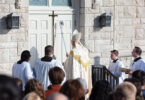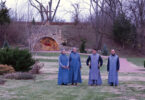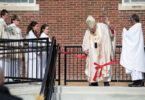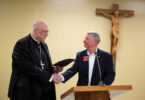The new English translation of the Third Edition of the Roman Missal debuts next weekend
by Joe Bollig
joe@theleaven.org
If you remember anything about the new Mass translation, please remember this: Be patient with Father.
Expect a little fumbling when the new translation of the Third Edition of the Roman Missal is implemented the first weekend of Advent, Nov. 26-27, said Michael Podrebarac, archdiocesan consultant for liturgy.
Sure, it will be difficult for lots of folks to wrap their tongues around new words like “consubstantial” and “incarnate.”
But the changes faced by the average Joe and Jane in the pews is nothing compared to what our priests will face.
“What’s going to be the most challenging aspect of [implementing] the new translation is that we have been praying most of these texts by heart,” said Podrebarac. “The priests have much of the Sacramentary committed to memory.”
The most changes — by far — are in the priest’s part of the Mass. And the changes aren’t limited to words and phrases, as is the case for the congregation, but also includes gestures.
So while he’s trying to read words as new to him as they are to all of us, he will also be trying to process the instructions that appear in red over certain passages. It’s the red type, you see, that directs him when to join his hands, or bow slightly, or make some other sort of symbolic gesture. And they’re as likely to be somewhat different from what he’s done all his priestly life as the words he’s reading.
And that’s not all.
The seminary teaches priests a lot about a lot of things, but it might not have taught your priest quite enough about music. Some priests cannot read music, yet with the new translation, celebrants are being encouraged — make that strongly encouraged — to sing parts of the Mass they haven’t sung before.
Is your pastor or associate pastor tone deaf? If you don’t know now, you’re going to find out.
Joe and Jane in the pew can take advantage of safety in numbers, but the priest can’t. He’s out there, alone. It’s a tough place to be sometimes.
So even if your priest is a veteran and a pro, he’s going to be nervous. It will be kind of like being fresh out of the seminary and newly ordained all over again.
Think of it this way. Let’s say you’ve been doing just great all these years in your career. But all of a sudden, you’re hauled back to high school to take a calculus test, or to gym class, so Coach Bullneck can scream at you to climb that rope.
Given all the new words, phrases, gestures and music, it’s only natural that Father is likely to be a tad nervous, said Podrebarac. So if you want to help, here’s another word for you to remember: Participate.
A touch of nostalgia
Certainly, lots of people (maybe your priest, too) will feel a twinge of nostalgia at the last celebration of the “old” Mass.
“It’s the only Mass many of us ever knew,” said Podrebarac. “It is the translation that has raised us in the faith. It has done a good job. It has served us well.”
“Although we now have the opportunity to experience an improved translation in terms of fidelity to the Latin and to the way in which we pray as Roman Catholics, as opposed to Catholics of other rites,” Podrebarac continued. “It is a good thing, this 1974 Sacramentary. New opportunities await us.”
Those opportunities include a deeper, richer, fuller participation in the Mass.
“There are word changes we can benefit from,” said Podrebarac. “[One is the] replacement of the word ‘fellowship’ with ‘communion,’ which is more of a transliteral rendering of ‘communio,’ the Latin rendering for the Greek ‘koinonia.’”
“We get to the heart of the matter,” he continued. “We are not simply here by our own election, but by being members of the communion of the Holy Spirit. While we give our assent to being here, and we may positively will it, we are called to enter into the liturgy.”
“We are all one in Christ, called together by the Holy Spirit — we truly are ‘one body, one spirit,’” said Podrebarac. “So the term ‘communion’ completes the idea.”
Keep on your toes
Another benefit is that people will have to keep on their toes, at least for the first year. And it will help to go like a Boy Scout: Be prepared.
“A good Catholic should, at the minimum, know the words they are expected to say when the First Sunday of Advent comes along,” said Father Paul Turner, pastor of St. Munchin Parish in Cameron, Mo. He serves as a facilitator for the International Commission on English in the Liturgy.
“Now, the parish will certainly have a card or participation aid in the pew to help them,” he added. “To help get ready, it would be good for them to look over the texts they’ll be saying and be prepared to respond and to say them accordingly.”
Father Turner has travelled all over the United States and six countries to help priests prepare for the new Mass translation. He recently returned from England, where they began to implement the new Mass translation before the United States.
“People notice the style of the translation is more formal than what they have experienced before,” said Father Turner. “It’s making them pay closer attention to the words at Mass.”
“I think the priests are struggling more than [the laypeople] are, because more of their words have changed,” he continued. “But everyone is in there with a good heart to serve the church and make it work.”
The occasion of the new Mass translation is also an opportunity for Catholics to invite those who might be curious or have fallen out of practice of the faith.
“I would encourage people to invite those who are not churchgoers to come with them and experience the new translation of the Mass,” said Father Turner.
“I think this is the natural time when people will be curious about how Catholics worship,” he noted.
“Some people have not wanted to come to Catholic worship because they didn’t know what words to say or when to stand or sit,” he said. “Well, we don’t know what words to say either! It’s a good time to try out the Mass with us.”
Q & A about the new translation
Q. Why have a new translation?
A. It was assumed by the Holy See and the U.S. Conference of Catholic Bishops that the English translation used since 1974 would need to be revised at some point. The Third Edition of the Roman Missal, announced in 2000 by Pope John Paul II, provided the occasion to accomplish an entirely new translation. In addition, the theory of how to best translate Latin into the vernacular had changed in the time since the publication of the version we’ve used up until now.
Q. Does this mean that the Eucharist was not celebrated properly in the past?
A. Not at all. The Second Edition of the Roman Missal was approved by the bishops and the Holy See, and it fostered the faith of Catholics for more than 40 years.
Q. Is this a new Mass?
A. Not really. It’s the same Mass, but a new translation. As the U.S. bishops have said, it’s “new words . . . deeper meaning, same Mass.”
Q. What will happen to the “old” missals?
A. They can be burned or buried, according to guidelines from the archdiocesan liturgy office. Some will end up in libraries as reference works. In any case, they are to be treated respectfully. Contact the liturgy office if you have any questions about how to dispose of yours.
Q. Do Catholics in the United States who speak Spanish also get a new translation?
A. Nothing will change in the Spanish Mass for the time being. A revised Spanish edition of the Roman Missal for use in the United States is in preparation.
Q. What’s new in the new missal?
A. New words, new phrases, some changed responses, and a more formal and elevated style. It has additional votive Masses, Masses for the Blessed Mother, and Masses for different occasions. It includes 17 additional saints days, an expanded body of orations, clarification of rubrics and better layout. It will have less gender-exclusive language.
Q. What about the music?
A. New music for the Mass settings has been written. Archdiocesan parishes began to use a limited amount of the music for the congregation’s parts since September, but more new compositions for the people’s and priest’s parts will begin to appear over time.
Q. Will the “new” Mass be difficult for me to follow?
A. It shouldn’t be. In fact, you will probably have a better experience because you’ll have to think a bit more and follow along more carefully.
The archdiocesan liturgy office has made many presentations throughout the archdiocese, and pastors have prepared parishioners in a number of ways — through bulletins inserts, homilies, pew cards, etc. You will likely find some easy-to-follow resource waiting for you in your pew, and a new missalette. Most people will get used to the changes within a year.
Q. Will the Scripture readings in the Liturgy of the Word change too?
A. No, not at this time. The Lectionary for Mass, approved for use in 1997, is undergoing some minor revisions. No date of implementation of these revisions has been announced.
Q. Can we continue to use the previous missal anyway?
A. No. The bishops have mandated use of the new translation at the Masses for the First Sunday of Advent, Nov. 26-27.
Q. What’s the bottom line? What are we trying to accomplish with the new translation?
A. The old saying is “Lex orandi, lex credendi,” or “What we pray is what we believe.” There is a direct relationship between the content of our prayers and our faith. The bishops hope that the new translation will produce a deeper, more thoughtful participation at Mass, and a deeper and richer prayer life.






